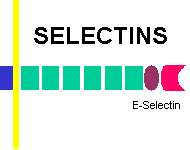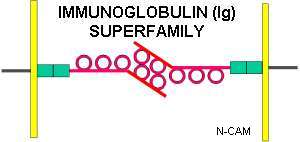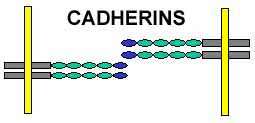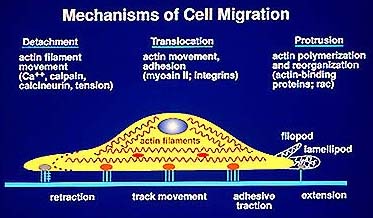Home, Search, Index, Links, Pathology, Molecules, Syndromes,
Muscle, NMJ, Nerve, Spinal, Ataxia, Antibody & Biopsy, Patient Info
|
Home, Search, Index, Links, Pathology, Molecules, Syndromes, Muscle, NMJ, Nerve, Spinal, Ataxia, Antibody & Biopsy, Patient Info |

|
||
|---|---|---|
General principles
|
||
| Molecule | Ligands | Distribution |
| L-selectin (CD62L)
|
Sulfated: GlyCAM-1 | Leukocytes (Homing receptor) |
| E-selectin (CD62e)
| Tetrasaccharides:
Sialyl-Lewisx;
Sialyl-Lewisa Cutaneous lymphocyte-associated antigen |
Endothelial cells |
| P-selectin (CD62P)
|
Tetrasaccharides: Sialyl-Lewisx P-selectin glycoprotein ligand-1 |
Endothelial cells Platelets |
| INTEGRINS | ||
|---|---|---|
General principles
|
||
| Molecule | Ligands | Distribution |
|
α1β1
|
Laminin; Collagen Tenascin, common form |
NK, B & Activated T cells; Fibroblasts; Glial Perineurium; Schwann cells; Endothelial |
| α2β1
| Laminin; Collagen | NK, B & Activated T cells; Platelets Endothelial; Fibroblasts; Epithelium Astrocytes; Schwann cells; Ependymal |
|
α3β1
| Laminin; Collagen; Fibronectin |
Activated T cells; Thymocytes; Endothelium; Fibroblasts; Epithelium; Astrocytes |
|
α4β1
|
α4β1;
α4β7;
Fibronectin; VCAM-1; MAdCAM-1; TSP-1 |
NK, B & T cells; Eosinophils; Endothelial; Muscle; Fibroblasts; Neural-crest derived Function: T cell Transendothelial migration |
| α5β1
|
Fibronectin; murine L1 | Activated B & T cells; memory T-cells; Thymocytes; Fibroblasts; Epithelium; Platelets; Endothelial; Astrocytes α-5 disease: Myopathy in Chimeric mouse |
|
α6β1
| Laminin | Leukocytes; Thymocytes; Epithelial; T cells (Memory & activated) Glial; Fibroblasts; Endothelial α-6 disease: Junctional epidermolysis bullosa |
| α7β1
| Laminin | Skeletal & cardiac muscle; Melanoma α-7 disease: Congenital MD Knockout ® Myopathy |
| α8β1
(CD-/CD29; VLA-8) |
Fibronectin; Vitronectin Tenascin, common form |
Epithelium; Neurons; Oligodendroglia |
| α9β1
|
Epithelium (airway); Muscle | |
| αvβ1
|
Vitronectin; Fibronectin; Collagen von Willebrand factor; Fibrinogen |
Oligodendroglia |
| αLβ2
(LFA-1α; CD11a) | ICAM-1; ICAM-2; ICAM-3 | Leukocytes; Thymocytes; Macrophages; T cells; Microglia β-2 disease: Leukocyte adhesion deficiency |
|
αMβ2
(CD11b) |
ICAM-1; Factor X; iC3b; Fibrinogen |
Myeloid; B cells (activated); NK cells; Macrophages; Microglia; B leukemic cells |
|
αXβ2
(CD11c) |
iC3b; Fibrinogen | Myeloid; Dendritic cells; B cells (activated); Macrophages; Microglia; B leukemic cells |
| αIIbβ3
| Fibronectin; Vitronectin; von Willebrand's factor; Thrombospondin | Platelets β-3 disease: Glanzmann thrombasthenia, Type B |
| αvβ3
(CD51/CD61) |
Fibronectin; Osteopontin; von Willebrand's factor; PE-CAM-1 Vitronectin; Fibrinogen; human L1 Thrombospondin; Collagen |
B cells (Activated);
T cells (Activated & γδ); Endothelium; Monocytes; Tumors; Glia; Schwann cells; Endothelium |
| α6β4
|
Laminin | Schwann cells; Perineurium;; Endothelium; Epithelium; Fibroblasts Not in immune cells β-4 disease: Junctional epidermolysis bullosa |
| αvβ5
(CD51/CD-) | Vitronectin; Fibronectin; Fibrinogen |
Fibroblasts; Monocytes; Macrophages; Epithelium; Oligodendroglia; Tumors |
| αvβ6
| Fibronectin | . |
|
αvβ8
|
Fibronectin | Oligodendroglia; Schwann cells; Brain synapses |
| α4β7
| Fibronectin; VCAM-1; MAdCAM-1 |
NK, B & T cells Not in neural cells |
| αIELβ7
(CD103) | E-cadherin | Intraepithelial T-lymphocytes (IEL) (Intestinal) |
| α11
|
Uterus, Heart, Skeletal muscle, Smooth muscle containing tissues |
|

|
||
|---|---|---|
General features
|
||
| NEURAL SPECIFIC IgCAMS | ||
| Molecule | Ligands | Distribution Disease |
| Abundant in CNS | ||
|
CHL1
|
CNS: Axon pathways | |
| L1CAM
|
Axonin
|
Neural: Wide CNS distribution SPG1 |
|
Neurofascin
|
Ankyrin-G
SCN1B; SCN3B |
Neural; Synapse NEDCPMD |
| NrCAM
|
Ig Superfamily | Neural: Ventral midline Neurons & Glia Motor Neuropathy; Neurodevelopmental Δ |
| Other Neural Ig-CAMs | ||
| Adhesion molecule on glia (AMOG; ATP1B2) |
Glial Neural migration |
|
| Contactin-1 (CNTN1) |
NOTCH1
|
Neural; NMJs Congenital myopathy, Lethal |
| Myelin-associated glycoprotein (MAG) |
MAG
|
Myelin Demyelinating Neuropathy |
| Myelin-oligodendrocyte glycoprotein (MOG) |
Myelin; Oligodendrocytes Cytoplasmic membranes |
|
|
NCAM-1
(CD56)
|
NCAM-1 via
polysialic acid Modulated by Sialyltransferase X Polysialyltransferase |
Neural cells Schwann cells, non-myelinating Satellite cells |
| NCAM-2
|
Neural | |
| OBCAM
|
Opioids (μ); Acidic lipids | Brain |
| P0 protein
|
P0 | Myelin |
| PMP-22 protein
|
PMP-22 | Myelin |
| CADM1 (SynCAM1; Necl2)
|
Ig Superfamily | Pre- & Postsynaptic; DRG Induces presynaptic differentiation |
|
CADM2 (SynCAM2; Necl3)
|
Necls & Nectins | Myelinated axons Binds to oligodendrocytes |
|
CADM3 (SynCAM3; Necl1)
|
Necl1, Necl2, Necl4 | PNS myelinated axons; DRG; CNS neurons |
|
CADM4 (SynCAM4; Necl4)
|
Necl1 | Myelinating Schwann cells; DRG Binds to CADM3 on axons |
|
MDGA1
|
Neural; Muscle Radial migration of cortical neurons |
|
| SYSTEMIC IgCAMS | ||
| Molecule | Ligands | Distribution |
| ALCAM (CD166)
|
CD6; CD166; NgCAM; 35 kD protein |
Neural; Leukocytes |
| Basigin (CD147)
|
MMP1
|
Leukocytes; RBCs; Platelets; Endothelial cells |
| BL-CAM (CD22)
|
Sialylated glycoproteins LCA (CD45) |
B-Lymphocytes |
|
CD44
|
Hyaluronin; Ankyrin; Fibronectin; MIP1β Osteopontin |
Lymphocytes; Epithelial; WM perivascular astrocytes Glial tumors (malignant) Metastases (CD44v splice variant) |
|
ICAM-1
(CD54)
|
αLβ2; LFA-1 | Leukocytes; Endothelial cells; Dendritic cells; Fibroblasts; Epithelium; Synovial cells Disease: Lys29Met mutation ↑ Susceptibility to cerebral malaria |
|
ICAM-2 (CD102)
|
αLβ2 (LFA-1) | Endothelial cells; Lymphocytes; Monocytes |
|
ICAM-3 (CD50)
|
αLβ2 | Leukocytes |
|
Lymphocyte function antigen-2 (LFA-2) (CD2) |
LFA-3 | Lymphocytes; Thymocytes |
|
LFA-3 (CD 58)
|
LFA-2 | Leukocytes; Stroma Endothelial cells Astrocytoma |
|
Major histocompatibility complex (MHC) molecules |
||
|
MAdCAM-1
|
α4β7; L-selectin | Mucosal endothelial cells |
|
PECAM
(CD31)
|
CD31; αvβ3 | Leukocytes; Synovial cells Endothelial cells |
|
T-cell receptor (C-region) |
||
|
VCAM-1
|
α4β1; α4β7 | Satellite cells Monocytes; Synovial cells; Activated endothelial cells |

|
|||
|---|---|---|---|
General principles
|
|||
| Molecule | Ligands | Distribution | |
|
Cadherin E (1)
|
H | Epithelial | |
|
Cadherin N (2)
|
O | Neural, Muscle | |
|
Cadherin BR (12)
|
M | Brain | |
|
Cadherin P (3)
|
O | Placental | |
|
Cadherin R (4)
|
P | Retinal | |
|
Cadherin M (15)
|
H | Muscle, Activated satellite cells | |
|
Cadherin VE (5)
|
I | Endothelial, Brain | |
|
Cadherin T & H (13)
|
L | Heart | |
|
Cadherin OB (11)
|
I | Osteoblast | |
|
Cadherin K (6)
|
C | Brain; Kidney | |
|
Cadherin 7
|
|||
|
Cadherin 8
|
Brain | ||
|
Cadherin KSP (16)
|
Kidney | ||
|
Cadherin LI (17)
|
GI tract; Pancreas | ||
|
Cadherin 18
|
CNS; Small cell lung cancer | ||
|
Cadherin, Fibroblast 1 (19)
|
Fibroblasts | ||
|
Cadherin, Fibroblast 2 (20)
|
Fibroblasts | ||
|
Cadherin, Fibroblast 3 (21)
|
Fibroblasts | ||
|
Cadherin 23
|
Ear | ||
|
Desmocollin 1
|
Skin | ||
|
Desmocollin 2
|
Epithelium, Mucosa Myocardium Lymph nodes |
||
|
Desmoglein 1
|
Epidermis, Tongue | ||
|
Desmoglein 2
|
All | ||
|
Desmoglein 3
|
Epidermis, Tongue Antibody target in pemphigus |
||
|
Protocadherin
1
7 |
|||
| OTHER ADHESION MOLECULES | ||
|---|---|---|
| Molecule | Ligands | Distribution |
|
Agrin (Neural)
|
MuSK; NCAM; Laminin Heparin-binding proteins; Heparan sulfate proteoglycan |
Nerve |
| CD34
|
MAdCAM-1; L-selectin | Immature lymph/myeloid |
| GlyCAM-1
|
L-selectin | Lymph nodes |
| Oligodendrocyte-myelin glycoprotein (OMGP) |
Myelin; Oligodendrocytes | |
 From Horwitz |
|
Adhesion molecules involved in leukocyte emigration from vessels during inflammation2 | |
| Rolling | Stopping |
|
Aggregation & Shape Change
|
Migration through vessel wall |